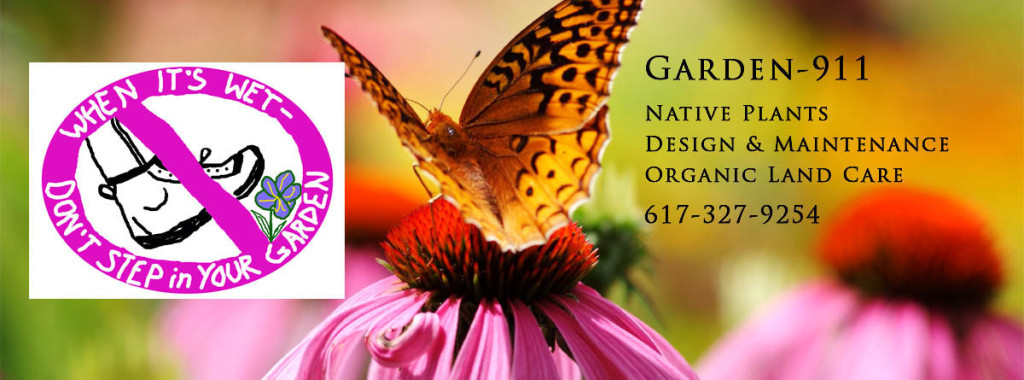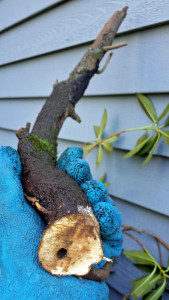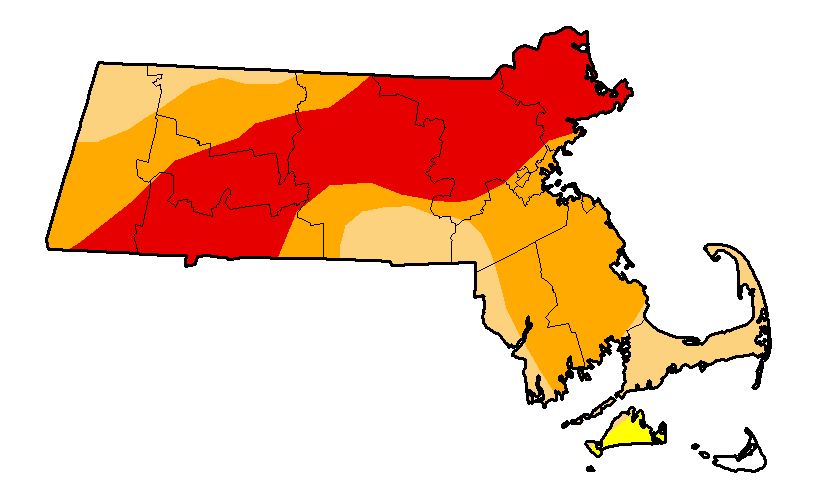What’s so great about a great lawn?
- Do you want a lawn that looks like a lush golf course? It’s going to cost you…and your neighbors, your town’s water quality and other natural resources. The typical best-in-the-neighborhood MA lawns are a mix of bluegrass, rye and fescue turf grasses. These are all cool season, non-native grasses that do not naturally do well here in our summer heat and droughts; these lawns need lots of time, energy and money to look as good as they do for as long as they do.
- The conventional practice is to follow the conventional high-input “advice” of landscape chemical companies’ and landscape vendors’ marketing efforts, including expensive fertilizer, insect and weed killers, bacteria and fungus killers, plus frequent mowing and watering.
- Your resulting “chem” lawn may look good, but it has negative and potentially hazardous impacts on your health and that of others; your wallet and that of others; and the wetland and ecosystems that filter pollutants from your water and mitigates flood damage, pollinates your food (everything we eat was once a plant), and provides natural settings for recreation and relaxation for you and others—among many other free but essential life services.
- Add it all up and you may realize what many others already know: that a “chem” lawn is actually more expensive and damaging than you ever thought. So ask yourself, “Is it really worth working and paying for a perfect lawn?” “Why should I care?” and, “What are healthier alternatives that save me money and time?”
What’s a sustainable lawn and why would it benefit you?
-
- SOIL AND WATER: Turf grasses naturally want to send their roots down about 6-12 inches into loamy topsoil that contains about 10% organic matter, such as compost. Established lawns want to be watered deeply (one inch of water) once a week, or one inch twice during hot weather. That way, their roots never dry out for extended periods and thus they don’t go into summer brownout/dormancy. Most irrigation systems are not programmed to water lawns on this kind of schedule. Instead, most water lightly several times a week, never delivering enough water to penetrate fully to the whole root system, so the water is largely wasted. What if you don’t have appropriate soil to support a robust lawn? See three bullet points below.
- TEST YOUR WATERING SYSTEM: You want one inch of water per week for established laws, so how do you find out how much water is actually being delivered? Before you turn on your sprinkler or your irrigation system comes on, put out a bunch of clean cat food or tuna fish cans to collect water. (Ask your friends and neighbors if you don’t have your own supply). After the system runs, use a ruler to measure how much water is in each can. If it’s not a little over an inch—the ruler will displace some water and increase the reading on the ruler—increase the run time and test again. Repeat adjustments until you get about an inch.
- SOIL TESTING: Get your soil tested to find out what kind of soil you have, your pH, your organic matter, and what amendments you can add to make your soil more ideal for your turf grasses. The most crucial part of soil testing is getting a truly representative sample. UMass has easy to follow recommendations for soil sampling, and they test soil for a reasonable fee. Learn more at https://ag.umass.edu/services/soil-plant-nutrient-testing-laboratory
- IF YOU DON’T HAVE IDEAL SOIL:
- Follow the recommendations from your soil test.
- Adjust your expectations and know that any lawn is a living work in progress.
- Good or poor soil, add ¼ to ½ inch of compost to your lawn every year late in the fall, after your last mowing. Over the winter it will improve your soil quality and improve lawn health. Do this every year, along with allowing your mowed grass clippings to fall and decompose in place, and you will not need to spend time and money fertilizing.
- Lime in the fall only if your soil test results call for it.
- If you feel you must fertilize, NEVER FERTILIZE WITHIN 100 FEET OF A WETLAND, VERNAL POOL OR POTENTIAL VERNAL POOL (or according to your local bylaw specifications). Beyond 100 feet (or according to your local bylaw specifications) of a wetland, vernal pool or potential vernal pool, apply an organic, slow release fertilizer just one time—and never just before or during a heavy rain—to your lawn between April 15th and October 15th. Limit that application to a maximum of 1 pound of nitrogen per 1000 square feet.
Organic fertilizers have non-water soluble nitrogen that releases to the soil at a steady rate over time. They help to build a healthy soil food web, as compared with conventional chemical fertilizers which are water soluble and result in nutrients (and your money) washing away as pollution into our waterways before they’re needed by your plants. A couple of readily available organic fertilizers are Espoma Garden-tone and Espoma Plant-tone. These are typically made of ground up feathers and bones rather than conventional petrochemicals. - Consider lawn alternatives
- Instead of turf grasses, use native, low-input sedges. Pennsylvania sedge, for instance, needs mowing only once a year and is drought tolerant after getting established.
- Add white clover to your lawn seed mix. Clover moves nitrogen from the soil to the ground and makes it available to green up your lawn
- Turn part of your lawn into an ornamental planting bed. Include native plants that are well adapted to our native soils. If well planned and designed, you’ll be saving time and money, supporting pollinators, improving water quality and the environment.
- SUN: Pay close attention to how many hours of mid-day sun each area of your lawn gets. Get a high quality grass seed mix to match the sun exposure. You can do many things to improve your soil—but changing the amount of sun your lawn gets is usually a bigger undertaking.
- MOWING: Set your mower to cut no lower than three inches. Use a mulching blade and let the clippings fall onto the lawn, where their nutrients will recycle right back into your soil, increasing your soil’s organic matter for free. Also, save time and money by not raking your leaves in the fall. Just mow them with a mulching blade and without a grass catcher, and leave them to in place to decompose. Again, free organic matter. Note: If mowing leaves a thick layer of leaves, though, spread them out with a rake so the grasses can still get some sun.
- WEEDS: Weeds don’t stand a chance if your turf grasses are robust, aka appropriate for where they’re growing and therefore nice and dense; grown in good deep soil with proper nutrients, organic matter, soil chemistry, water and sun.
- INSECTS: Most insects, approximately 99% by number of species, are native insects that play a crucial role in the food web that supports our environment, that in turn supports people. Properly identifying and learning the life cycle of pests is the most important step in managing them. Many are beneficial. If you don’t want to learn about it, get help from a natural or organic horticulturist to learn if you have a normal amount of bugs or an infestation that needs management.
- BACTERIAL AND FUNGAL CONDITIONS: Most bacterial and fungal conditions in lawns occur because the lawn’s cultural conditions—including soil nutrients, pH and organic matter; sun exposure and water—do not favor a robust lawn planted with non-native, cool season grass species. You can spend lots of hazardous chemical resources and still not get the results you want.
- AERATING YOUR LAWN: Most lawns do not need to be aerated annually. Lawn areas that have high traffic have compacted soils that make it very difficult for grasses to thrive. Most of us are familiar with the fact that plants take in carbon dioxide and release oxygen, but this is only what the plant does above ground. Plants’ roots do the opposite, taking oxygen from the tiny spaces between tiny soil particles. If the lawn soil is compacted or constantly wet, your turf grasses’ roots cannot get the oxygen they need to thrive, and the above-ground portion of the grasses will not do well. If you choose to aerate, do not use any device with a solid spike shape, as these will only compact your soil further. Instead, use a tool or machine that has cylindrical-shaped fittings that will remove plugs of soil. These greatly reduce compaction and bring oxygen into the soil for the roots.
- WHEN TO TOP DRESS OR INSTALL A NEW LAWN: The single best time by far is September, for a long list of reasons.
- ADDITIONAL RESOURCES:
-
- Do not use Wikipedia
- Use the site that searches only state extension service sites that provide peer-reviewed scientific information: https://impact.extension.org/search/
- Town of Falmouth, MA Healthy Lawns, Health Waterways document on how to grow a healthy lawn without fertilizer: http://www.falmouthmass.us/DocumentCenter/View/950/Fertilizer-Facts—Falmouths-Nitrogen-Control-Bylaw-PDF?bidId=
-





